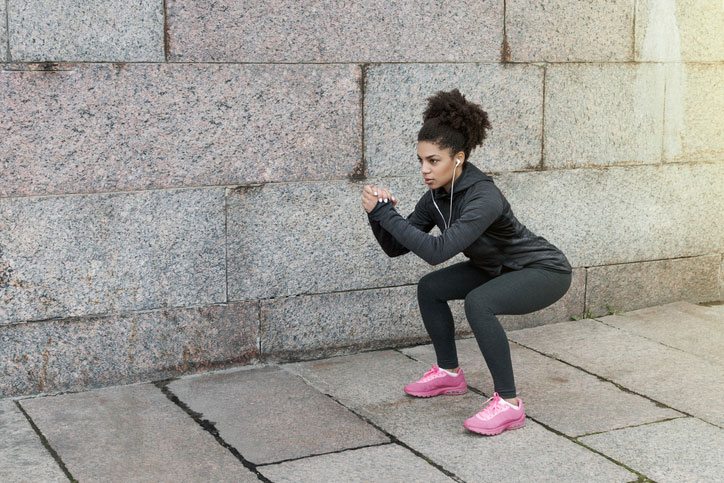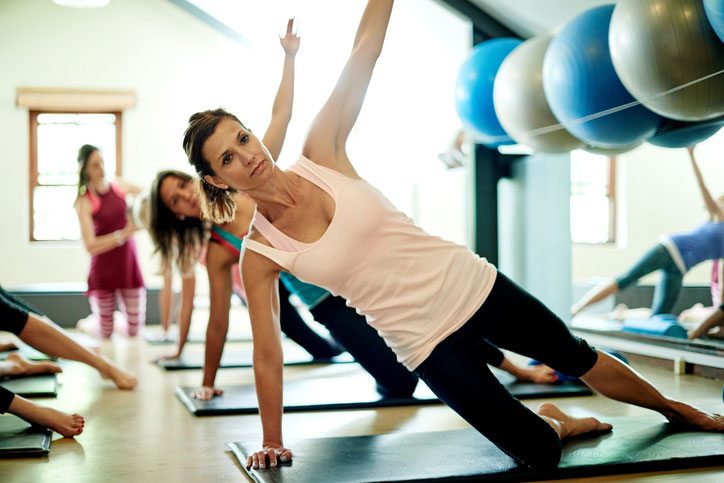Want to give your sex life a reboot? Training a certain set of muscles could help. Here are eight pelvic floor exercises that will spice up your sex life
If you’re a gym bunny, it’s likely that you give most of your muscles a fair bit of attention. But there’s one group of muscles that don’t get talked about enough and certainly don’t get enough TLC. Our pelvic floor muscles are crucial, not only for supporting our organs from the bladder to the anus (and everything in between) but they also have a big impact on our sex lives. Reports suggest that one-third of adult women in the UK are affected by pelvic floor disorders which can leave them with a whole host of problems including incontinence and an unwillingness to have sex due to pain, lack of feeling or simply embarrassment. Intimate health brand Intimina found that only half of women asked feel confident in their pelvic floor muscles. And on top of that, only 35 percent of them admitted to performing Kegel exercises only sometimes and a further 19 percent revealed they performed them almost never.
We spoke to three women’s physiotherapists about why it’s so important to keep on top of those muscles and the different ways we can exercise to strengthen our pelvic floor – and improve our sex lives in the process.
How will training my pelvic floor improve my sex life?
So how can this muscle help improve sex? Physiotherapist, physiopilates instructor and spokesperson for the Professional Network of Pelvic, Obstetric and Gynaecological Physiotherapists Amanda Savage, puts it simply – ‘Vaginal sensation is felt with pressure and deep touch more than light sensations. Sexual pleasure comes from the movement and build-up of friction against the vaginal walls. The vaginal walls are layered with the pelvic floor muscles. Pelvic floor muscle exercises tone and strengthen these muscles, improving blood supply and nerve activity, all leading to greater pleasure. Many women report they are able to reach orgasm more easily, and that their orgasms are more powerful, after focusing on pelvic floor muscle exercises.’
These muscles are big players when it comes to penetrative sex and like other muscles, when we build them up, they get stronger and bulkier. Physiotherapist and PhD student, Kate Lough describes how improving the strength of this muscle can spice up your sex life. ‘If you go to the gym for six months you’ll see a difference, your shoulders and hamstrings might get more muscular – it’s the same with your pelvic floor. You will get a bulkier pelvic floor that is going to take up more room and it will mean that the space available for a penis or whatever you’re using will be smaller and you may be more aware of what’s going in and out.’ And it isn’t just physical, Lough explains that it’s psychological too, ‘If you’ve got a fantastic pelvic floor and you feel that it’s worthy of some really great sex, the chances are you’re going to have some really great sex. If you feel as though your pelvic floor muscles are weak and your partner says ‘It’s not the same since you had the kids’ the loss of confidence can be just as big a factor as the possibility of weaker muscles for less satisfactory sex. Knowing that your pelvic floor muscles can improve can help you build your self-confidence.’
We spoke to three women’s health physio experts about the different ways to exercise our pelvic floor and spice our sex life up in the process. First, the basics.
How to contract your pelvic floor
‘The simplest, easiest, cheapest way to do pelvic floor exercises (and the way that’s been around for thousands of years) is to tighten and release your muscles’ says Savage. So how exactly is that done? Lough explains it in a way that might leave you blushing but makes the technicalities of the movement very clear. ‘I always tell people to think about their back passage and imagine they’re going to slide a poo back up the tube. If you can’t go to the toilet for some reason, you have to slide it back up the storage cupboard – tighten up your back passage as much as you can and draw right in.’ And if that doesn’t make much sense to you? ‘If that doesn’t work you can think about where your labia are – and try and close them together tight or try to tuck your wee hole under the bone at the front. You can sit on your hands so that your bum bones are on your hands and then try and slide your bum bones together without clenching your buttocks,’ (don’t forget to breathe!) Got it? Right, the next step is to try and hold the muscle contraction and then release.
It’s very easy to store a lot of tension in your pelvic floor and you can get pains and your muscles can go into spasms
To build endurance: squeeze and hold
Much like a bicep, Savage explains that there is only one type of contraction that you can do with your pelvic floor. ‘Your bicep muscle has one action – it folds your hand towards your arm. Your pelvic floor has its own special action, drawing in and sucking – it’s the movement you do when you’re trying to hold your wee or stop yourself from passing wind.’ The amount of time you’re able to hold for will vary from woman to woman but if you have no dysfunction, the experts say you should aim to hold for around 10 seconds. Christien Bird, women’s health physio and owner of the White Hart Clinic suggests doing this hold 10 times – and then doing that twice a day to see the best results.
To build speed: short, powerful squeezes
Building up your pelvic floor muscle is not only going to make you feel more confident in the bedroom but if you suffer from a weaker pelvic floor this exercise also has the power to make a huge difference to your day-to-day life. Pelvic floor muscles kick in when we sneeze, pass wind or feel that our bladder might leak. By practising short, powerful squeezes we can improve their capabilities and learn to squeeze them in time to cough, keeping our wee in our bladder. Using the technique that you learned in exercise one Savage explains, ‘Like all muscles in the body the pelvic floor muscles can perform in different ways. Practice short, powerful squeezes (10-15 in a row).’ Draw your muscles in quickly and release, repeating this in short bursts.
For mid-sex pleasure: hold while he’s inside you
Now it’s time to put that endurance building squeeze and hold into practice. As Lough says, ‘It’s good to know where those muscles are and then when it comes to your sex life you can decide to have a bit of fun with it. During sex, you can squeeze and try and get your partner to feel it. Use those muscles for some effect, for some fun.’ The more firmed and toned you are, the more you’ll feel yourself and your partner during sex and according to the professionals, this will help to improve your orgasms.
To reduce muscle tension: don’t forget to release
Bird explains that one thing that is incredibly important to remember is that releasing those muscles is just as essential as tightening them up. Like some women are unable to tighten those muscles, other women may find it difficult to let them go. ‘It’s like if you lift your arm and hold it with a weight to strengthen it – you don’t leave your arm up there, you bring it down again. It’s very easy to store a lot of tension in your pelvic floor and you can get pains and your muscles can go into spasms.’ It can be the result of urinary tract infections, bouts of cystitis or even stress and anxiety that causes your muscles to tense but one thing is for certain, it can have a huge impact on intimacy. ‘There’s a group of women we see that have pain during sex and that can be due to an overactive pelvic floor.’
While suffering from this may mean having to see a professional, there are ways that you can work on this in the privacy of your own home. ‘On your own, you can practice releasing your pelvic floor. Try and tighten up your pelvic floor and if you don’t feel much movement there, you may already be tensing. Release your tummy and let that space between your bum bones open out – it’s really about feeling your tummy go really floppy… if you’re struggling with this, it may be useful to go and see a physio.’
If you’re doing things that make you feel good, you generally have more confidence and you’ll feel that things are better
For a multi-purpose exercise: squat
From building strength to burning calories, we’ve all heard about the benefits of squatting. But there may just be one more. ‘When you squat, you contract your glutes – your big bottom muscles. If you do that and you’re lucky enough to be someone that has an automated co-contraction of your pelvic floor then without you doing anything else you can just squat and your pelvic floor muscles will kick in,’ explains Bird. While this is a great way for many women to exercise the pelvic floor, it doesn’t work for everyone. And in some rare cases such as prolapse, it can even be damaging which is why the experts insist it’s important for you not to feel embarrassed about any problems you may have. Lough says ‘Some women have real issues around prolapse – they join a gym and are too embarrassed to tell the instructor about their problem and then they get inappropriate exercises which are loaded with too much pressure and their pelvic floors are too weak to cope with them.’ As a rule, the experts say if any exercise starts to make your problem worse – go and see an expert.
For a confidence boost: Pilates
If you’ve got the squeezing and tensing down, Pilates can really help with pelvic floor training. Savage explains how ‘All Pilates exercises aim to work your core muscles together as a group. The core muscles used are your abdominals, your pelvic floor, your back muscles and your diaphragm. You first focus on learning to use each one separately (the basic pelvic floor, the basic abdominals, the basic breath) but then the goal of Pilates is to use them all in balance together. Once you are certain that you are definitely using your pelvic floor correctly you will include your pelvic floor in all your pilates exercises too. You will be practising using your pelvic floor muscles not just in isolation but as part of all movements. This is a great progression from the basic pelvic floor exercises as in real life all our muscles have to work together and we have to do lots of complex movements.’
While Pilates has been heralded as helping with pelvic floor training, the experts fall on two sides. Lough believes that Pilates can be very useful for many women hoping to train their pelvic floor but adds, ‘some women will tell me how they used to leak and since doing a Pilates DVD for six months they feel better and they’ll say it’s all because of those exercises. It may be because of those exercises but it might also be because they’ve taken the time to look after themselves properly for the first time and if they’d done any other exercise they may have seen the same results.’ The pelvic floor specialist admits there can be a hugely positive psychosexual impact. ‘If you’re doing things that make you feel good, you generally have more confidence and you’ll feel that things are better.’ In turn, this newfound confidence will spice things up in the bedroom.
While there are no magic Pilates moves that you can specifically do to target your pelvic floor, Savage suggests paying extra attention to your pelvic floor while exercising to ensure you’re engaging the muscles. ‘If you have a problem with your pelvic floor muscles (clues are incontinence or vaginal prolapse) it is important not to rush up to the advanced levels of Pilates too quickly. You and your instructor need to keep checking that your abdominal wall is not bulging and that you don’t feel pressure below in the vagina with any of the tasks. If you do feel pressure below you need to go back down a pilates level. Not all Pilates instructors will emphasise the pelvic floor.’
The digital fix: pelvic floor toning apps
In the age of all answers coming from the internet, is it any wonder that there’s an app for pelvic floor training too? Multiple apps in fact. Physiotherapist Bird is a fan of one created by the NHS called the Squeezy app, ‘it gives you notifications to remind you to train. If you know how to do an effective contraction and how long you can hold for you can individualise your training (although you may need an assessment for this) and it gives you really simple instructions on how to do your exercises. It costs a couple of pounds but it has a visual aid that goes up and down as you squeeze and you have to keep up with it – that will help you train your speed.’
For a bit of help: pelvic floor trainers
And if you’re really struggling to do it on your own, there are plenty of gadgets you can invest in. There are a whole host of pelvic floor trainers that work in a variety of ways. The experts say that if you’re struggling to train your pelvic floor simply by following instructions to squeeze and you aren’t able to see a professional, a gadget might be the thing for you. Trainers like Elvie can be inserted into your vagina and then tracked and used from your phone and others such as the Intimina use vibrations to help you squeeze and a sensor to help you progress by moving you up a level depending on your performance. With the Elvie being handed out at goodie bags in this year’s Emmy’s, this once taboo trend is turning over a stylish leaf (if it’s good enough for the red carpet, it’s good enough for us).
Still struggling? Follow this link to the POGP website and download a free pelvic floor guide written by physiotherapists.
Read more
A personal trainer for your vagina? There’s an app for that!
Designer vagina – do I need it?
Like this article? Sign up to our newsletter to get more articles like this delivered straight to your inbox.

























































